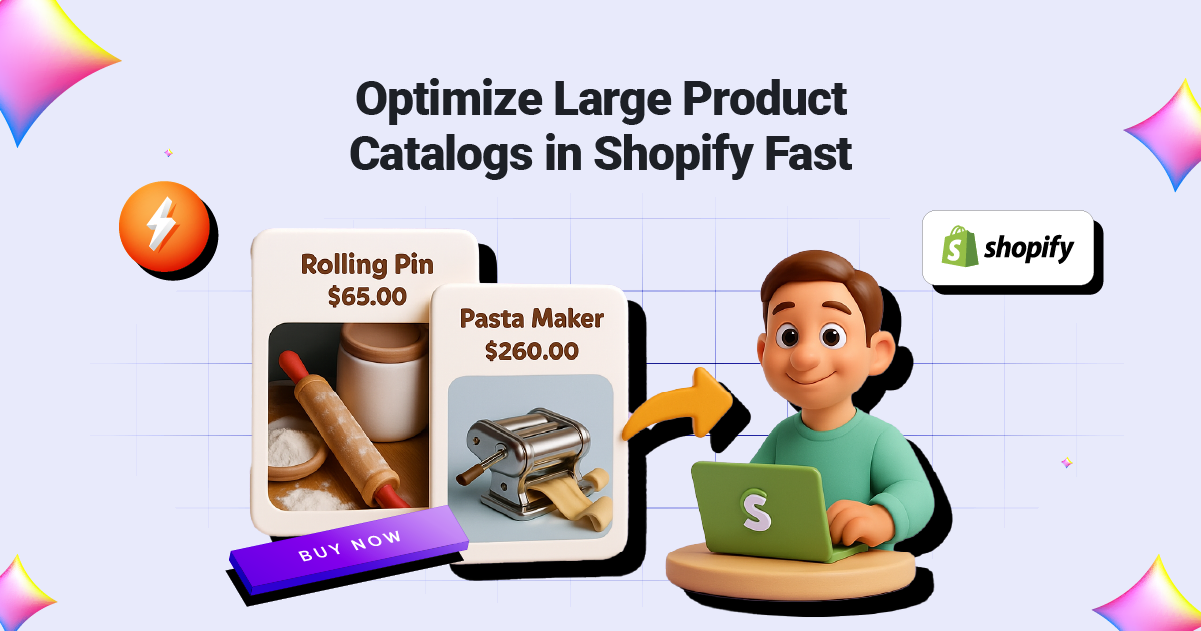
As eCommerce continues to evolve, businesses with extensive product catalogs face unique challenges—particularly when it comes to maintaining a fast, seamless, and scalable online shopping experience. Shopify, one of the most popular eCommerce platforms, is well-equipped to handle large inventories, but only when optimized effectively.
If your Shopify store is experiencing slow load times, broken filters, or sluggish searches due to a large product catalog, it’s time to implement some proven performance techniques. In this blog, we’ll explore how to optimize large product catalogs in Shopify and improve site speed, user experience, and conversion rates.
Why Large Product Catalogs Slow Down Shopify Stores
A large product catalog—typically defined as having thousands of SKUs—can strain Shopify’s capabilities if not managed properly. The consequences of poor catalog performance include:
- Slower page load speeds
- Delays in search functionality
- Inefficient navigation and filtering
- Higher bounce rates and lower SEO rankings
To avoid these pitfalls, store owners must apply best practices in Shopify Development to ensure their site runs efficiently at scale.
1. Use Shopify Collections Strategically
One of the best ways to organize and optimize large product catalogs is by creating well-structured collections. Collections group related products, making it easier for users to find what they’re looking for.
Tips for optimizing collections:
- Use automated collections to reduce manual work and ensure real-time updates.
- Limit the number of products displayed per page using pagination or infinite scroll.
- Create niche-specific collections based on popular keywords or customer interests.
2. Optimize Images for Speed and Quality
With thousands of products come thousands of images, and uncompressed or oversized images can be a huge performance killer.
Image optimization tips:
- Compress images using tools like TinyPNG or ImageOptim before uploading.
- Use Shopify’s built-in image CDN to serve optimized images based on user location.
- Convert images to modern formats like WebP for better compression.
Also, consider using lazy loading to ensure images load only when they enter the user’s viewport, rather than loading all at once.
3. Implement Smart Filtering and Search
A robust search and filter experience is essential for large catalogs. Shopify’s default search may not scale well, so consider integrating advanced tools like:
- Shopify Search & Discovery App
- Algolia or InstantSearch+
- Custom-built filters using metafields and tags
When implementing filters:
- Avoid overloading pages with filter options.
- Use dynamic filters that update based on user selections.
- Minimize client-side JavaScript processing for faster performance.
4. Optimize Your Theme for Performance
Themes play a vital role in how your site performs. Choose a theme designed for speed and optimized for large inventories.
Theme optimization tips:
- Minimize unused JavaScript and CSS.
- Use liquid logic to conditionally load scripts and resources.
- Enable theme sections like “Quick View” sparingly to reduce DOM load.
If your current theme isn’t optimized, consider investing in custom Shopify Development to create a tailored theme built specifically for large product catalogs.
5. Utilize Shopify Metafields Wisely
Metafields allow you to store custom data for products, collections, and variants. They’re essential for managing large catalogs with complex product attributes.
To ensure performance:
- Keep metafields structured and concise.
- Use Shopify’s new native metafields UI instead of third-party apps when possible.
- Avoid overloading the front-end with unnecessary metafield data.
6. Limit Third-Party Apps
While apps can add powerful features, they can also bloat your site and slow it down—especially if each app loads its own scripts and styles.
Tips:
- Audit your app usage regularly.
- Remove unused or redundant apps.
- Choose lightweight or server-side apps over front-end-heavy ones.
Many features (such as pop-ups, filters, or badges) can be implemented directly through code without relying on third-party apps.
7. Enable Content Delivery Network (CDN) and Caching
Shopify includes a fast global CDN by default, which helps deliver content from the nearest server to your customer. But there are still steps you can take:
- Reduce the number of API calls made per page.
- Use caching wherever possible—especially for frequently accessed data.
- Leverage Shopify Hydrogen or headless CMS if you’re ready for advanced setups.
8. Monitor Performance with Analytics
It’s impossible to improve what you don’t measure. Use tools like:
- Google PageSpeed Insights
- Shopify’s Analytics Dashboard
- Hotjar or Crazy Egg for heatmaps and user behavior
Regularly monitor performance metrics, bounce rates, and user flows to identify problem areas and make data-driven improvements.
Final Thoughts
A large product catalog doesn’t have to slow your Shopify store down. With strategic planning, optimized themes, and smart use of Shopify’s features, you can deliver a high-performance shopping experience no matter how big your inventory grows.
If you’re ready to take your store to the next level, consider partnering with a professional team specializing in Shopify Development to help streamline, scale, and supercharge your eCommerce business.
